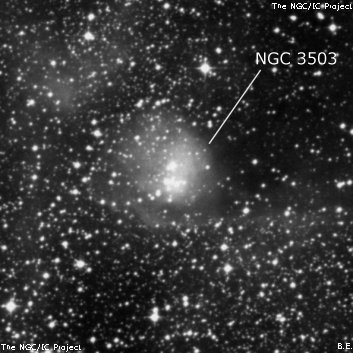
John Herschel discovered NGC 3503 = h3311 on 1 Apr 1834 and described "3 very close stars, 10m, in a nearly straight line, and a double star north of them, the whole involved in a very faint nebula." Paris Pismis reported it as new in her 1959 list of 24 new clusters found with the Schmidt camera at the Tonantzila observatory and noted "Quadruple star in nebulosity plus five faint stars; is the center of arcs that extend up 15'. Similar to NGC 2467." Interestingly, Joseph Turner found no nebulosity using the 48" Melbourne Telescope on 14 Feb 1879 (p.202 in logbook).
600/800mm - 24" (4/5/08 - Magellan Observatory, Australia): The brightest section of this nebulosity surrounds a group of 5 stars, consisting of a brighter mag 10.5 star with a faint, close companion (h4397 = 10.6/13.3 at 8") and three additional stars in a string. Several additional faint stars spiral out from the grouping. The haze that surrounds these 5 stars is ~3' in diameter. There was little or no contrast gain using a UHC filter, so the nebulosity does not have a significant emission component. Situated in a rich star field.
Notes by Steve Gottlieb